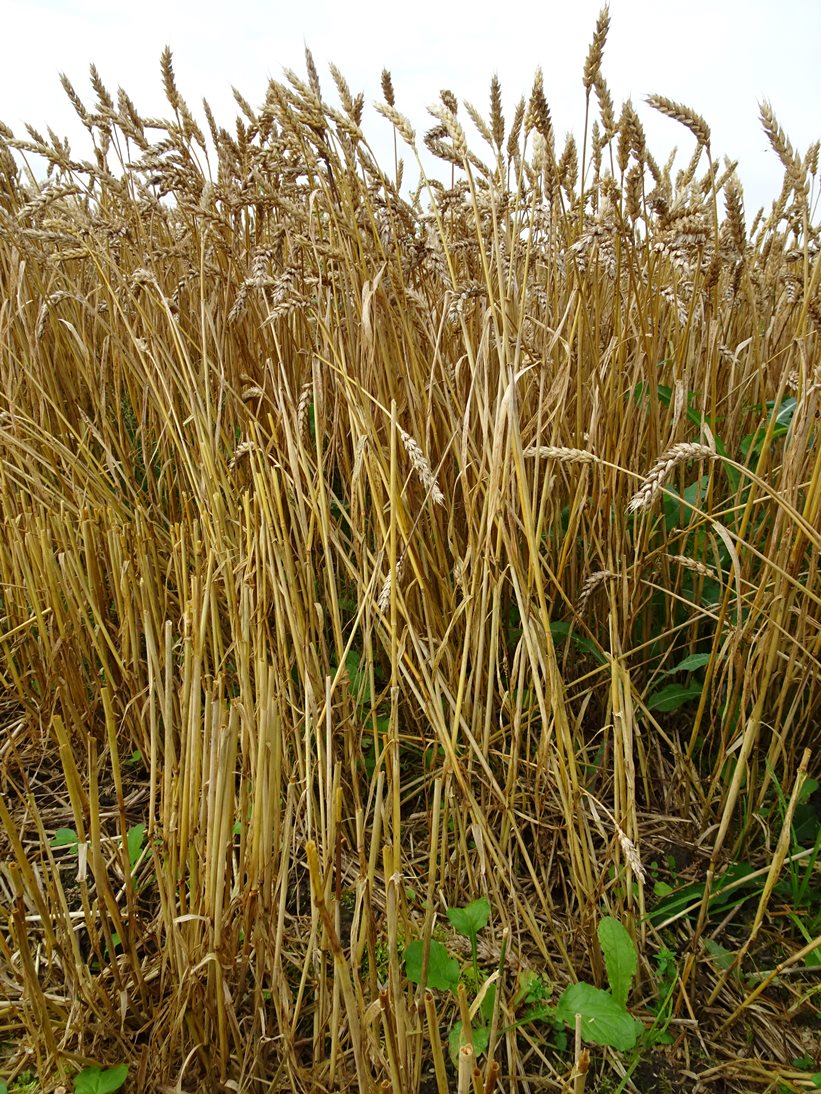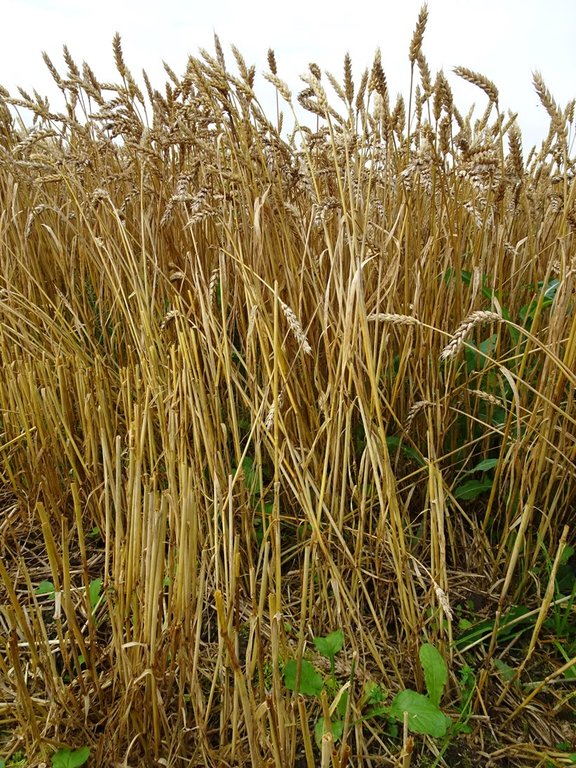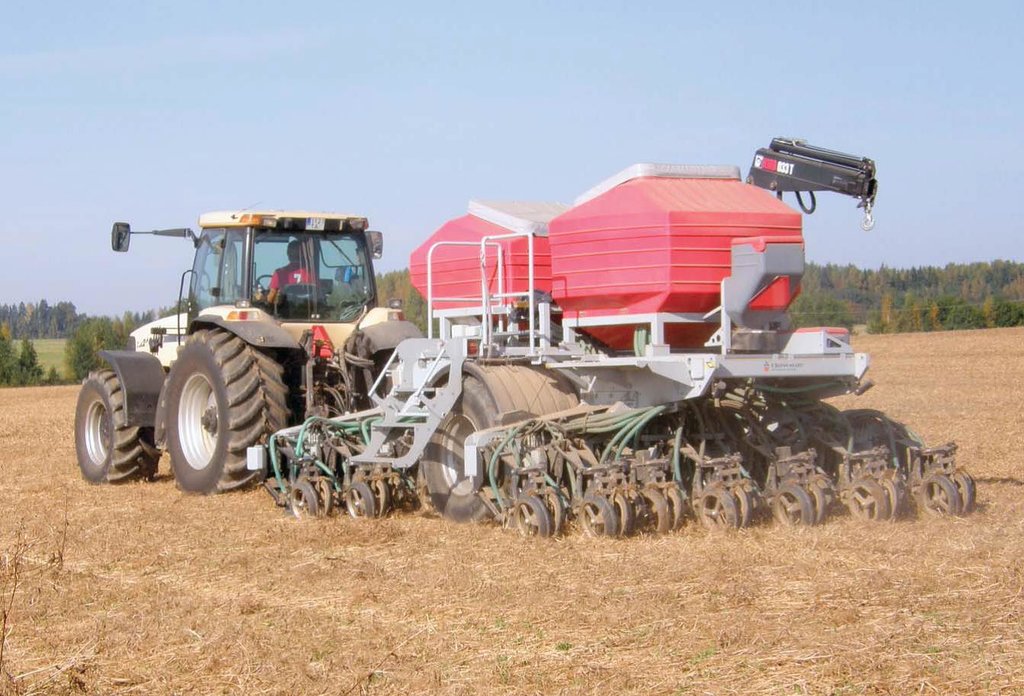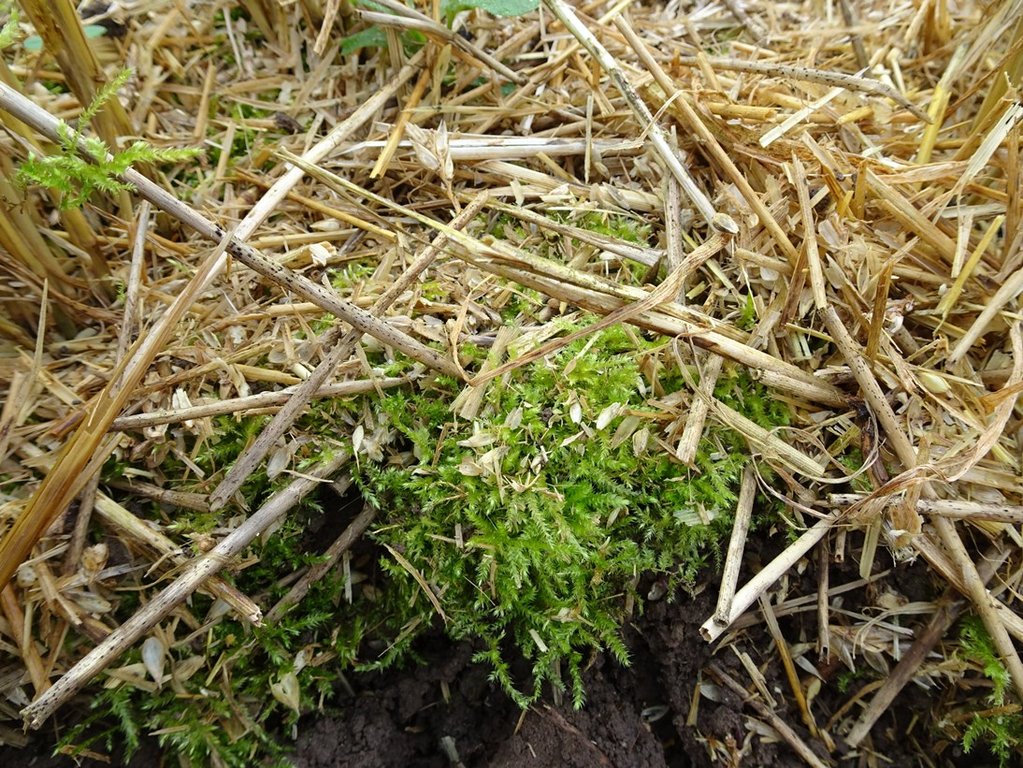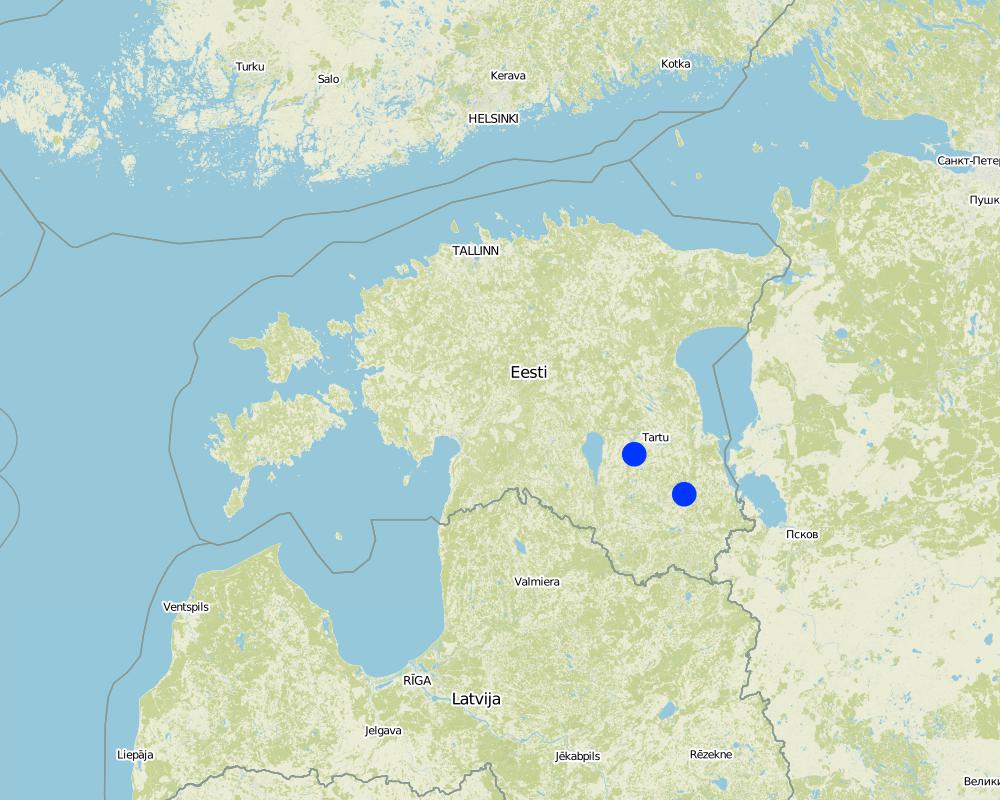No-tillage [استونيا]
- تاريخ الإنشاء:
- تحديث:
- جامع المعلومات: Endla Reintam
- المحرر: –
- المراجعون: Ursula Gaemperli, Gudrun Schwilch, Alexandra Gavilano
Otsekülv
technologies_3089 - استونيا
عرض الأقسام
توسيع الكل طي الكل1. معلومات عامة
1.2 تفاصيل الاتصال بالأشخاص الرئيسيين لمصدر المعلومات والمؤسسات المشاركة في تقييم وتوثيق التقنية
مستخدم الأرض:
Tobreluts Toomas
Pirmastu OÜ
استونيا
researcher:
Penu Priit
Estonian Agricultural Research Centre
استونيا
اسم المشروع الذي سهّل توثيق/تقييم التقنية (إذا كان ذلك على صلة)
Interactive Soil Quality assessment in Europe and China for Agricultural productivity and Environmental Resilience (EU-iSQAPER)1.3 الشروط المتعلقة باستخدام البيانات الموثقة من خلال WOCAT
يوافق جامع المعلومات والشخص (لاشخاص) الرئيسي لمصدر المعلومات على الشروط المتعلقة باستخدام البيانات الموثقة من خلال WOCAT:
نعم
1.4 إعلان بشأن استدامة التقنية الموصوفة
هل التقنية الموصوفة هنا تمثل مشكلة فيما يتعلق بتدهور الأراضي، بحيث لا يمكن إعلانها تقنية مستدامة لإدارة الأراضي؟:
كلا
2. وصف تقنيةالإدارة المستدامي للأراضي
2.1 وصف مختصر للتقنية
تعريف التقنية:
No-till farming (also called zero tillage or direct drilling) is a way of growing crops or pasture from year to year without disturbing the soil through tillage.
2.2 وصف تفصيلي للتقنية
الوصف:
The technology is applied in sub-humid climate with an average of 696 mm of precipitations per year, from which more comes from July to October and less in March and April. Average annual temperature is +4 C, length of the growing period is 180-195 days. The territory is mostly flat, the southern part is hilly with slopes of 6-10%. Average altitude from the sea level is 50 m. About half of the Estonian territory is above 50 m and half is below it. Soils are from very shallow (less than 0.1 m) in the north to very deep (> 120m ) in the south. Soil cover is very variable. In the agricultural area the soils are medium textured with low (< 1%) to high (>5%) organic matter in topsoil. Groundwater is near the surface in wet soils and deep in hilly areas. Biodiversity varies from high to low depending on soil and landscape. Market orientation of production system is mixed and off-farm income is less than 10%. Relative level of wealth is average from individual households to cooperatives. Soil management is mechanized. Land belongs to land users, but is leased also in case of bigger farms (over 100 ha).
The purpose of the technology is to reduce soil disturbance and with that to reduce erosion and leaching, increase carbon storage, water infiltration and biological activity. Only 5-10% of the soil surface is disturbed during sowing. The drilling is made by special machinery and thus no-till farming requires specialized seeding equipment designed to plant seeds into undisturbed crop residues and soil. Drilling depth depends on the specific needs of the culture. If the straw remains on the field, it should be chopped to smaller pieces (25-40 mm). For direct seeding it is good if the previous culture was seeded with wider spacing, for example 25 cm and harvest height is 15-20 cm. New sowing will be done between previous crop rows. The highest investment to this technology is the new drilling machine. At the same time there is no need for special tillage machines. In order to help eliminate weed, pest and disease problems, crop rotations and pesticides are used. The system is not suitable for root crops. The no-till system is suitable for cereal based cropping systems as well as for renewing grasslands. The suitable crop rotation, for exampe, is: winter oilseed rape - winter wheat - pea (or bean) - winter wheat - spring barley undersown with red clover - red clover. The main benefit is the reduced working time, fuel costs and with that the lower net-cost of the product, but also the better soil structure. The adoption of the technology may increase weediness and pests and decrease the yield due to the preliminar soil compaction of upper 10-20 cm soil layer. If the soil surface of the field is not enough levelled out, the uniformity of the depth of the seedlings can suffer. There is also increased use of pesticides to control weeds, pests and diseases compared to minimum and conventional tillage. The technology is most suitable for medium-texture soils.
2.3 صور التقنية
2.5 البلد/المنطقة/المواقع التي تم تنفيذ التقنية فيها والتي يغطيها هذا التقييم
البلد:
استونيا
المنطقة/الولاية/المحافظة:
Tartu county, Põlva county
مزيد من التفاصيل حول الموقع:
Tartu county, Meeri; Põlva county, Puuri
حدد انتشار التقنية:
- منتشرة بالتساوي على مساحة
إذا كانت المساحة الدقيقة غير معروفة، فيرجى الإشارة إلى المنطقة التقريبية المغطاة:
- 10-1 كم2
التعليقات:
The total area of no-till in Estonia is ca 42 000 ha. On the farm near Tartu it is 1700 ha of land, of which 300 ha are grasslands. The farm near Põlva encompasses an area of 850 ha of which 330 ha are grasslands. The whole area of both farms is managed by no-tillage.
Map
×2.6 تاريخ التنفيذ
في حالة عدم معرفة السنة بالتحديد، يرجى الإشارة إلى التاريخ التقريبي:
- منذ أقل من 10 سنوات (مؤخرًا)
2.7 إدخال التقنية
حدد كيف تم إدخال التقنية:
- من خلال ابتكار مستخدمي الأراضي
3. تصنيف تقنية الإدارة المستدامي للأراضي
3.1 الغرض الرئيسي ( الأغراض الرئيسية) للتقنية
- الحد من تدهور الأراضي ومنعه وعكسه
- reduce tillage cost
3.2 نوع (أنواع) استخدام الأراضي الحالية حيث يتم تطبيق التقنية

الأراضي الزراعية
- زراعة سنوية
الزراعة السنوية - حدد المحاصيل:
- الحبوب - الشعير
- الحبوب - الشوفان
- الحبوب - شيلم
- wheat
عدد مواسم الزراعة في السنة:
- 1
حدد:
One harvest of cereals.
3.3 هل تغير استخدام الأراضي نتيجة لتنفيذ التقنية؟
هل تغير استخدام الأراضي نتيجة لتنفيذ التقنية؟:
- نعم (يرجى ملء الأسئلة أدناه فيما يتعلق باستخدام الأراضي قبل تنفيذ التقنية)

الأراضي الزراعية
- زراعة سنوية
التعليقات:
Before implementation of the no-tillage the conventional and/or reduced tillage was used.
3.4 إمدادات المياه
إمدادات المياه للأرض التي يتم تنفيذ التقنية عليها:
- بعلية
3.5 مجموعةالإدارة المستدامة للأراضي التي تنتمي إليها هذه التقنية
- تحسين الغطاء الأرضي/النباتي
- الحد الأدنى من اختلال التربة
3.6 التدابير التقنية في مجال إلادارة المستدامة للأراضي

التدابير الزراعية
- A3: معالجة سطح التربة
3.7 الأنواع الرئيسية من تدهور الأراضي التي تناولتها التقنية

تآكل التربة بالمياه
- الوزن(Wt): فقدان التربة السطحية/تآكل السطح

تآكل التربة الناتج عن الرياح
- (Et): فقدان التربة السطحية

التدهور الكيميائي للتربة
- (Cn): تراجع الخصوبة وانخفاض محتوى المادة العضوية (غير ناتج عن الانجراف)

التدهور المادي أو الفيزيائي للتربة
- (Pc) : تراص التربة
3.8 منع أو حد أو عكس تدهور الأراضي
تحديد هدف التقنية فيما يتعلق بتدهور الأراضي:
- منع تدهور الأراضي
- الحد من تدهور الأراضي
4. المواصفات الفنية، وأنشطة التنفيذ، والمدخلات، والتكاليف
4.1 الرسم الفني للتقنية
المواصفات الفنية (المتعلقة بالرسم الفني):
The agrotechnology in case of no-tillage depends on available equipments (drill). If the straw remains on the field, it should be chopped to smaller pieces of 25-40 mm. For direct seeding it is good if the previous culture was seeded with wider spacing, for example 25 cm. Harvest height is 15-20 cm. New seeding will be done between previous crop rows.
المؤلف:
Endla Reintam
التاريخ:
14/08/2017
4.2 معلومات عامة بخصوص حساب المدخلات والتكاليف
حدد كيفية احتساب التكاليف والمدخلات:
- لكل وحدة تقنية
حدد الوحدة:
per hectare
عملة أخرى/ عملة وطنية (حدد):
EUR
إذا كان ذا صلة، وضح سعر الصرف من الدولار الأمريكي إلى العملة المحلية (على سبيل المثال، 1 دولار أمريكي = 79.9 ريال برازيلي): 1 دولار أمريكي =:
1,18
اذكر متوسط تكلفة أجر العمالة المستأجرة في اليوم الواحد:
36-40 EUR/day + taxes
4.3 أنشطة التأسيس
| النشاط | التوقيت (الموسم) | |
|---|---|---|
| 1. | New direct seeder |
التعليقات:
If you are already active in agriculture, the investment is the new seeder. You also need to have machinery to spread fertilizers and pesticides.
4.4 التكاليف والمدخلات اللازمة للتأسيس
| تحديد المدخلات | الوحدة | الكمية | التكاليف لكل وحدة | إجمالي التكاليف لكل مدخل | % من التكاليف التي يتحملها مستخدمو الأراضي | |
|---|---|---|---|---|---|---|
| معدات | Direct seeder (3m) | piece | 1,0 | 25000,0 | 25000,0 | 100,0 |
| إجمالي تكاليف إنشاء التقنية | 25000,0 | |||||
| إجمالي تكاليف إنشاء التقنية بالدولار الأمريكي | 21186,44 | |||||
إذا تحمل مستخدم الأرض أقل من 100% من التكاليف، حدد من قام بتغطية التكاليف المتبقية:
It is possible to apply for an investment support up to 50% of the total price (governmental tool till the year 2020).
التعليقات:
The cost of the direct seeder depends on the farmers prefererences regarding the technology. The cheapest direct seeder can be purchased for ca. 25 000 EUR. Better quality of a cross slot seeder that places seeds under the soil (technical drawing and picture) costs ca 200 000 EUR (working width 4.6 m).
4.5 الصيانة/الأنشطة المتكررة
| النشاط | التوقيت/الوتيرة | |
|---|---|---|
| 1. | Sowing together with fertilization | before drilling (spring crops in spring (April), winter crops in autumn (August)) |
| 2. | Plant protection | in spring 2 weeks before sowing, herbicides, during growth period depending on the needs ca 3 times |
| 3. | Fertilization during growth period | For winter crops in spring after snowmelt in the beginning of growth, for spring crops in the beginning of intensive growth |
| 4. | Harvest and grain transport | At the end of season (end of July to beginning of September depending of the crop) |
| 5. | Drying of grain and soil tillage | after harvest |
التعليقات:
The need of plant protection depends on the field conditions. Less pesticides are needed if proper crop rotation with break crops is established and weeds are thus suppressed.
4.6 التكاليف والمدخلات اللازمة للصيانة/للأنشطة المتكررة (سنويًا)
| تحديد المدخلات | الوحدة | الكمية | التكاليف لكل وحدة | إجمالي التكاليف لكل مدخل | % من التكاليف التي يتحملها مستخدمو الأراضي | |
|---|---|---|---|---|---|---|
| معدات | Sowing with fertilization | times | 1,0 | 55,9 | 55,9 | 100,0 |
| معدات | Plant protection | times | 4,0 | 11,2 | 44,8 | 100,0 |
| معدات | Fertilization during growth period | times | 1,0 | 16,2 | 16,2 | 100,0 |
| معدات | Harvest and grain transport | times | 1,0 | 118,4 | 118,4 | 100,0 |
| معدات | Drying and after harvest activities | times | 1,0 | 132,1 | 132,1 | 100,0 |
| المواد النباتية | seeds | kg | 200,0 | 0,28 | 56,0 | 100,0 |
| الأسمدة والمبيدات الحيوية | Ammonium nitrate (2x per season) | kg | 147,0 | 0,84 | 123,48 | 100,0 |
| الأسمدة والمبيدات الحيوية | Complex fertilizer (27 kg N, 40 kg P and 112 kg K per ha) (450 kg of fertilizer per ha) | kg | 179,0 | 0,74 | 132,46 | 100,0 |
| الأسمدة والمبيدات الحيوية | Herbicides (2 times) | times | 2,0 | 27,0 | 54,0 | 100,0 |
| الأسمدة والمبيدات الحيوية | Fungicides (1 time) | times | 1,0 | 33,2 | 33,2 | 100,0 |
| الأسمدة والمبيدات الحيوية | Insecticides (1 time) | times | 1,0 | 3,6 | 3,6 | 100,0 |
| الأسمدة والمبيدات الحيوية | Retartants | times | 1,0 | 14,0 | 14,0 | 100,0 |
| إجمالي تكاليف صيانة التقنية | 784,14 | |||||
| إجمالي تكاليف صيانة التقنية بالدولار الأمريكي | 664,53 | |||||
التعليقات:
The labour costs are included to the machinery work costs. On average the labour cost for a driver is 15-18 EUR/ha.
The average machinery work costs to produce 6 t of winter wheat were 432 EUR/ha, 400 EUR/ha and 780 EUR/ha in conventional, minimum and no-tillage, respectively in 2016. Cost of production in this case was 137 EUR/t, 132 EUR/t and 128 EUR/t in conventional, minimum and no-tillage, respectively.
To produce the same amount of spring barley, the cost of machinery was 431 EUR/ha, 411 EUR/ha and 366 EUR/ha in conventional, minimum and no-tillage, respectively. Cost of production in this case was 123 EUR/t, 121 EUR/t and 114 EUR/t in conventional, minimum and no-tillage, respectively. It means that the cost of production is 8-11 EUR less than compared with plough based production.
Fuel cost is ca 50% less than in conventional plough based farming.
4.7 أهم العوامل المؤثرة على التكاليف
قدم وصفا لأهم العوامل التي تؤثر على التكاليف:
Fuel price, labour costs.
5. البيئة الطبيعية والبشرية
5.1 المناخ
هطول الأمطار السنوي
- < 250 مم
- 251- 500 ملم
- 501 - 750ملم
- 1,000-751 ملم
- 1,500-1,100 ملم
- 2,000-1,500 ملم
- 3,000-2,001 ملم
- 4,000-3,100 ملم
- > 4000 ملم
حدد متوسط هطول الأمطار السنوي (إذا كان معروفًا)، بالملليمتر:
696,00
المواصفات/التعليقات على هطول الأمطار:
Average 696 mm, almost equally spread over the year, more from July to October, less in March and April.
الإشارة إلى اسم محطة الأرصاد الجوية المرجعية المعنية:
Tartu Tõravere
المنطقة المناخية الزراعية
- شبه رطبة
LGP 180-195 days
5.2 طوبوغرافيا
متوسط الانحدارات:
- مسطح (0-2%)
- بسيط (3-5%)
- معتدل (6-10%)
- متدحرج (11-15%)
- تلال (16-30%)
- شديدة الانحدار(31-60%)
- فائقة الانحدار (>60%)
التضاريس:
- هضاب/سهول
- أثلام مرتفعة
- المنحدرات الجبلية
- منحدرات التلال
- منحدرات في السفوح
- قاع الوادي
المنطقة الارتفاعية:
- 100-0 متر فوق سطح البحر
- 500-101 متر فوق سطح البحر
- 1,000-501 متر فوق سطح البحر
- 1,500-1,001 متر فوق سطح البحر
- 2,000-1,501 متر فوق سطح البحر
- 2,500-2,100 متر فوق سطح البحر
- 3,000-2,501 متر فوق سطح البحر
- 4,000-3,001 متر فوق سطح البحر
- > 4000 متر فوق سطح البحر
وضح ما إذا كانت التقنية مطبقة على وجه التحديد في:
- حالات محدبة أو نتؤات
5.3 التربة
متوسط عمق التربة:
- ضحل جدًا (0-20 سم)
- ضحلة (21-50 سم)
- متوسطة العمق (51-80 سم)
- عميقة (81-120 سم)
- عميقة جدًا (> 120 سم)
قوام التربة (التربة السطحية):
- متوسط ( طميي، سلتي)
قوام التربة (> 20 سم تحت السطح):
- متوسط ( طميي، سلتي)
المواد العضوية في التربة السطحية:
- متوسطة (1-3%)
إذا كان متاحًا، قم بإرفاق وصف كامل للتربة أو تحديد المعلومات المتوفرة، على سبيل المثال نوع التربة، الرقم الهيدروجيني/ درجة حموضة التربة، قدرة التبادل الكاتيوني، النيتروجين، الملوحة وما إلى ذلك.
Soil type: sandy loam Stagnic Luvisol; N 0.12%, Corg 1.15%; C:N 9.97, P 4.35 mg/100g, K 10.19mg/100g, Ca 49.61mg/100g, Mg 12.19mg/100g, pH 6.0
5.4 توافر المياه ونوعيتها
منسوب المياه الجوفية:
50-5 م
توافر المياه السطحية:
جيد
نوعية المياه (غير المعالجة):
مياه شرب جيدة
هل تعتبر ملوحة الماء مشكلة؟:
كلا
هل تحدث فيضانات في المنطقة؟:
كلا
5.5 التنوع البيولوجي
تنوع الأنواع:
- متوسط
تنوع الموائل:
- متوسط
التعليقات والمواصفات الإضافية بشأن التنوع البيولوجي:
Soil biodiversity is higher compared to conventional tillage.
5.6 خصائص مستخدمي الأراضي الذين يطبقون التقنية
مستقر أو مرتحل:
- غير المترحل
التوجه السوقي لنظام الإنتاج:
- مختلط (كفاف/ تجاري)
الدخل من خارج المزرعة:
- أقل من % 10من كامل الدخل
المستوى النسبي للثروة:
- متوسط
أفراداً أو مجموعات:
- فرد/أسرة معيشية
- تعاونية
مستوى المكننة:
- ميكانيكية/ مزودة بمحرك
الجنس:
- نساء
- رجال
عمر مستخدمي الأرضي:
- شباب
- متوسط العمر
5.7 متوسط مساحة الأرض التي يستخدمها مستخدمو الأراضي الذين يطبقون التقنية
- < 0.5 هكتارا
- 0.5 - 1 هكتار
- 1 -2 هكتار
- 2 - 5 هكتار
- 5 - 15 هكتار
- 15 - 50 هكتار
- 50 - 100هكتار
- 500-100 هكتار
- 1,000-500 هكتار
- 10,000-1,000 هكتار
- > 10,000 هكتار
هل يعتبر هذا نطاقًا صغيرًا أو متوسطًا أو واسعا (في إشارة إلى السياق المحلي)؟:
- على نطاق متوسط
التعليقات:
The farm near Tatu owns 1700 ha of land, of which 300 ha are grasslands. The farm near Põlva encompasses a total of 850 ha of which 330 ha are grasslands. All soils of both farms are managed by no-tillage.
5.8 ملكية الأراضي، وحقوق استخدام الأراضي، وحقوق استخدام المياه
ملكية الارض:
- دولة
- فردية، يوجد سند ملكية
حقوق استخدام الأراضي:
- مؤجر
- فردي
حقوق استخدام المياه:
- وصول مفتوح (غير منظم)
- فردي
5.9 الوصول إلى الخدمات والبنية التحتية
الصحة:
- ضعيف
- معتدل
- جيد
التعليم:
- ضعيف
- معتدل
- جيد
المساعدة التقنية:
- ضعيف
- معتدل
- جيد
العمل (على سبيل المثال خارج المزرعة):
- ضعيف
- معتدل
- جيد
الأسواق:
- ضعيف
- معتدل
- جيد
الطاقة:
- ضعيف
- معتدل
- جيد
الطرق والنقل:
- ضعيف
- معتدل
- جيد
مياه الشرب وخدمات الصرف الصحي:
- ضعيف
- معتدل
- جيد
الخدمات المالية:
- ضعيف
- معتدل
- جيد
6. الآثار والتصريحات الختامية
6.1 الآثار التي أظهرتها التقنية في الموقع
الآثار الاجتماعية والاقتصادية
الإنتاج
إنتاج المحاصيل
التعليقات/ حدد:
In different years the crop production may be higher than by ploughing, but another year lower. There has been decrease of spring barley yield by 0.1 t/ha. Winter wheat yield has been ca 1.4 t/ha higher than by ploughing.
جودة المحاصيل
التعليقات/ حدد:
No statistically significant difference has been found. However, winter wheat 1000 grain weight was reported 39.6 g by no-tillage and 38.5 g by ploughing.
إدارة الأراضي
التعليقات/ حدد:
No need for soil tillage. Instead of several machinery to till the soil, one compact sowing machine is needed.
الدخل والتكاليف
النفقات على المدخلات الزراعية
التعليقات/ حدد:
Less cost for fuel because 50% less fuel is needed compared with ploughing.
دخل المزرعة
التعليقات/ حدد:
Even if the yield is a little bit lower or the same as with ploughing, the unit cost to produce barley or winter wheat is 8-11 EUR less than with ploughing.
عبء العمل
التعليقات/ حدد:
No time to be spent for tillage. Even extra spreading of pesticides takes less time than ploughing and other tillage operations.
الآثار الاجتماعية والثقافية
الأمن الغذائي / الاكتفاء الذاتي
التعليقات/ حدد:
Unit cost of the production is lower and thus it is possible to sell production cheaper.
المعرفة بالإدارة المستدامة للأراضي/تدهور الأراضي
التعليقات/ حدد:
If land was eroded before and soil was on the road, everybody can see the differences after establishment of the grasslands. It is not so severe in case of peatlands, however, less tractors will stuck in to the mud on rainy period.
الآثار الايكولوجية
دورة المياه / الجريان السطحي
حصاد / جمع المياه
التعليقات/ حدد:
Residues remaining on the soil surface help to catch more snow during the winter.
الجريان السطحي
التعليقات/ حدد:
Plant residues protect soil surface structure from raindrop effects, allowing water to infiltrate quicker in the soil.
تصريف المياه الزائدة
التعليقات/ حدد:
Undisturbed soil pore structure allows water quicker to drain in the deeper soil layers. Water permeability of long-term no-till soil is 2 times higher than under conventional management.
التبخر
التعليقات/ حدد:
Residues on the soil surface do not allow quick evaporation, protecting soil surface.
التربة
رطوبة التربة
التعليقات/ حدد:
Soil moisture content was 3% higher than by ploughing, but not significantly.
غطاء التربة
الكمية قبل الإدارة المستدامة للأراضي:
0
الكمية بعد الإدارة المستدامة للأراضي:
100%
التعليقات/ حدد:
The soil is covered by plants or by plant residues during the whole year.
فقدان التربة
التعليقات/ حدد:
Residues and plant cover stop both wind and water erosion.
تراكم التربة
التعليقات/ حدد:
Reduced decomposition of organic matter increases organic carbon content by 0.1-0.2%.
تكون قشرة التربة السطحية/انسداد مسام التربة
التعليقات/ حدد:
No crust after applying no-tillage as plant residues protect the soil surface.
تراص التربة
التعليقات/ حدد:
Increased from the top (by 0.04 g/cm3) but decreased deeper in the soil by 0.08 g/cm3) compared to the ploughing. No plough pan. Soil penetration resistance was 1 MPa lower between 20-40 cm under no-tillage compared to ploughing.
دورة المغذيات/إعادة الشحن
التعليقات/ حدد:
Due to the decreased decomposition of organic matter and the increase of organic carbon, more nitrogen remains in the soil.
المادة العضوية في التربة/تحت الطبقة c
التعليقات/ حدد:
It was found that there was slight increase of organic carbon (Corg) by 0.1-0.2% in upper 5 cm of soil compared to ploughing.
التنوع البيولوجي: الغطاء النباتي، الحيوانات
الغطاء النباتي
التعليقات/ حدد:
Plant/residue cover is during the whole year.
الكتلة الحيوية/ طبقة الكربون فوق التربة
التعليقات/ حدد:
As there is no tillage, all residues remain on the soil surface.
التنوع النباتي
التعليقات/ حدد:
Due to the need of changes in crop rotation, more diverse rotations instead of monoculture to suppress weeds. Weeds diversity might increase and change due to the reduced tillage intensity.
التنوع الحيواني
التعليقات/ حدد:
More spiders, beetles, ants compared with ploughing.
الأنواع المفيدة
الكمية قبل الإدارة المستدامة للأراضي:
2 species of earthworms
الكمية بعد الإدارة المستدامة للأراضي:
3-4 species of earthworms
التعليقات/ حدد:
More earthworm species and higher abundance compared with ploughing.
تنوع الموائل
التعليقات/ حدد:
No-till areas create different pattern to the landscape.
مكافحة الآفات/الأمراض
التعليقات/ حدد:
Some diseases and pests are surpressed, but there is increase of slugs and snails.
الحد من مخاطر المناخ والكوارث
انبعاث الكربون والغازات المسببة للاحتباس الحراري
التعليقات/ حدد:
Due to the reduced use of fuels for tillage, less greenhouse gases will be released. 0.05 kg/ha less greenhouse gases per kg yield is reported by no-tillage compared to ploughing.
خطر الحريق
التعليقات/ حدد:
Dry plant residues are a high risk in spring.
المناخ الموضعي (مايكرو)
التعليقات/ حدد:
Due to the residue cover the soil temperature and water content fluctuations are smaller.
6.2 الآثار التي أظهرتها التقنية خارج الموقع
القدرة على التخفيف / الترشيح
التعليقات/ حدد:
Due to the higher amount of organic matter, the nutrients and water holding capacity is higher.
الرواسب المنقولة بواسطة الرياح
التعليقات/ حدد:
No wind erosion after applying no-tillage.
الأضرار التي لحقت بحقول الجيران
التعليقات/ حدد:
No sediments from the field to the neighbours fields.
الضرر على البنية التحتية العامة/ الخاصة
التعليقات/ حدد:
In case of erosion, no soil is carried by water or wind to the ditches and on the roads.
آثار الغازات الدفيئة
التعليقات/ حدد:
Due to the reduced use of fuels for tillage, less greenhouse gases will be released. 0.05 kg/ha less greenhouse gases per kg yield is reported by no-tillage compared to ploughing.
6.3 تعرض التقنية وحساسيتها لتغير المناخ التدريجي والظواهر المتطرفة/الكوارث المرتبطة بالمناخ (كما يراها مستخدمو الأراضي)
تغير مناخ تدريجي
تغير مناخ تدريجي
| الموسم | زيادة أو نقصان | كيف تتعامل التقنية مع ذلك؟ | |
|---|---|---|---|
| درجة الحرارة السنوية | زيادة | غير معروف | |
| درجة الحرارة الموسمية | الشتاء | زيادة | غير معروف |
| درجة الحرارة الموسمية | الربيع | زيادة | غير معروف |
| هطول الأمطار السنوي | زيادة | غير معروف | |
| هطول الأمطار الموسمية | الشتاء | زيادة | غير معروف |
| هطول الأمطار الموسمية | الخريف | زيادة | غير معروف |
الظواهر المتطرفة / الكوارث المرتبطة بالمناخ
الكوارث الجوية
| كيف تتعامل التقنية مع ذلك؟ | |
|---|---|
| عاصفة ممطرة محلية | غير معروف |
| عاصفة رعدية محلية | غير معروف |
| عاصفةبَرَد محلية | غير معروف |
| عاصفة ثلجية محلية | غير معروف |
| عاصفة هوائية محلية | غير معروف |
الكوارث المناخية
| كيف تتعامل التقنية مع ذلك؟ | |
|---|---|
| موجة باردة | غير معروف |
| ظروف شتاء قاسية | غير معروف |
| حريق الأرض | ليس جيدا |
6.4 تحليل التكلفة والعائد
كيف يمكن مقارنة العوائد نسبة لتكاليف الإنشاء (من وجهة نظر مستخدمي الأراضي)؟
عوائد قصيرة الأجل:
سلبي قليلا
عوائد طويلة الأجل:
إيجابي
كيف تتم مقارنة العوائدمع كلفة الصيانة/التكاليف المتكررة (من وجهة نظر مستخدمي الأراضي)؟
عوائد قصيرة الأجل:
إيجابي
عوائد طويلة الأجل:
إيجابي
6.5 اعتماد التقنية
- 1-10%
إذا كان متاحًا، قم بتحديد الكمية (عدد الأسر المعيشية و/أو المساحةالمغطاة):
7% from agricultural land
من بين جميع الذين تبنوا التقنية، كم عدد الذين فعلوا ذلك بشكل تلقائي، أي دون تلقي أي حوافز مادية/مدفوعات؟:
- 51-90%
التعليقات:
It is possible to get investment support from the governmental agricultural tools up to 50% from the total cost of equipment.
6.6 التكيف
هل تم تعديل التقنية مؤخرًا لتتكيف مع الظروف المتغيرة؟:
كلا
6.7 نقاط القوة / المزايا / الفرص التي توفرها التقنية
| نقاط القوة/ المزايا/ الفرص من وجهة نظر مستخدمي الأراضي |
|---|
| Decreases work load and time, also fuel consumption, increases income. |
| Increases soil biological activity, soil organic matter content, better structure and infiltration, decreases erosion. |
| نقاط القوة/ المزايا/ الفرص من وجهة نظر جامع المعلومات أو غيره من الاشخاص الرئيسيين لمصدر المعلومات |
|---|
| Decrease of soil organic carbon decomposition, decrease of erosion, increase of soil biological activity. |
6.8 نقاط ضعف / مساوىء / مخاطر التقنية وسبل التغلب عليها
| نقاط الضعف/ المساوىء/ المخاطر من وجهة نظر مستخدم الأراضي | كيف يمكن التغلب عليها؟ |
|---|---|
| High preliminary investment (seeder), increase of weediness and pests, | Investment support, better crop rotation. |
| نقاط الضعف/ المساوىء/ المخاطر من وجهة نظر جامع المعلومات أو غيره من الاشخاص الرئيسيين لمصدر المعلومات | كيف يمكن التغلب عليها؟ |
|---|---|
| Higher use of pesticides and therefore risk to soil and water pollution. | Suggestion of changes in crop rotation, cover crops. |
7. المراجع والروابط
7.1 طرق جمع/مصادر المعلومات
- زيارات ميدانية، مسوحات ميدانية
2 during the iSQAPER project, more than 5 in total with other projects
- مقابلات مع مستخدمي الأراضي
2, more than 5 in total with other projects
- التجميع من التقارير والوثائق الأخرى الموجودة
6
متى تم تجميع البيانات (ميدانيا)؟:
04/06/2017
7.2 المراجع للمنشورات المتاحة
العنوان، المؤلف، السنة، النظام القياسي الدولي لترقيم الكتب ISBN:
Minimeeritud harimine ja otsekülv. 2017. P. Viil. Eesti Taimekasvatuse Instituut. ISBN 978-9949-9742-2-1
متاح من أين؟كم التكلفة؟:
ISBN 978-9949-9742-2-1
7.3 روابط للمعلومات ذات الصلة على الإنترنت
العنوان/الوصف:
Kattetulu arvestused taime- ja loomakasvatuses 2016. Koost: Marju Aamisepp, Helle Persitski. Maamajanduse infokeskus. 2017.
عنوان الرابط URL:
http://www.maainfo.ee/data/trykis/kattetulu/KATTETULU2016.pdf
العنوان/الوصف:
Statistics Estonia
عنوان الرابط URL:
https://www.stat.ee/en
العنوان/الوصف:
Erinevate viljelusmeetodite ( sh. otsekülv) rakendusteaduslik kompleksuuring. Riikliku programmi “Põllumajanduslikud rakendusuuringud ja arendustegevus aastatel 2009–2014” projekti lõpparuanne. 2015. Eesti Taimekasvatuse Instituut, Eesti Maaülikool, Põllumajandusuuringute keskus.
عنوان الرابط URL:
http://www.pikk.ee/upload/files/Erinevad_viljelusviisid_pikk_aruanne.pdf
العنوان/الوصف:
Minimeeritud harimine ja otsekülv. 2017. P. Viil. Eesti Taimekasvatuse Instituut.
عنوان الرابط URL:
http://taim.etki.ee/taim/public/pdf/Trukised/Otseklv-minimeeritud-mullaharimine.pdf
العنوان/الوصف:
Eesti maaelu arengukava 2014-2020 4. ja 5. prioriteedi meetmete ja 3. prioriteedi loomade heaolu meetme püsihindamisaruanne 2015. aasta kohta ja Lisad 1-30
عنوان الرابط URL:
http://pmk.agri.ee/mak/avaleht/
العنوان/الوصف:
Eesti tuleviku kliimastsenaariumid aastani 2100
عنوان الرابط URL:
https://www.envir.ee/sites/default/files/kliimastsenaariumid_kaur_aruanne_ver190815.pdf
الروابط والوحدات المواضيعية
توسيع الكل طي الكلالروابط
لا يوجد روابط
الوحدات المواضيعية
لا يوجد وحدات مواضيعية


